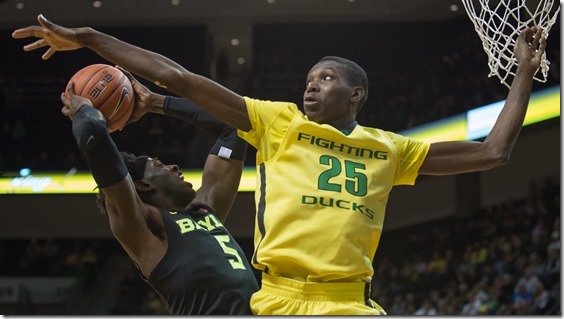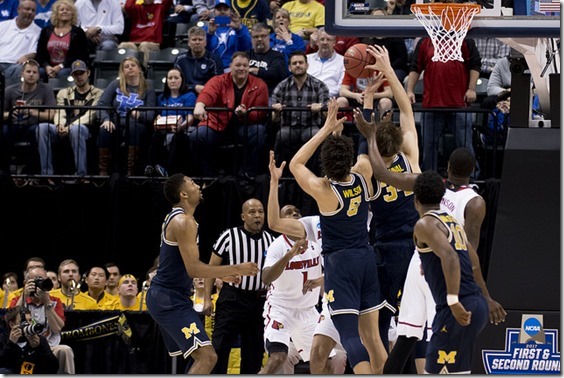Boucher tore his ACL in the Pac-12 tournament
The absent man. Oregon post Chris Boucher is a major, major loss for the Ducks. Boucher played 20 minutes a game with excellent shooting (63/35) on high-ish usage; he has a top-ten block rate nationally; he is an excellent rebounder. In the three games since he went out, Oregon's given up
- 1.19 PPP against Arizona, the #17 Kenpom offense,
- 1.10 PPP against Iona, the #69 Kenpom offense, and
- 1.13 PPP against Rhode Island, the #59 Kenpom offense.
That looks like a major step back for a team with an adjusted D efficiency of 0.95 PPP.
In the aftermath, smallball. Oregon was already an up-and-down team playing one big, and now they are more so. 6'9" Jordan Bell is a terrific athlete who replicates most of what Boucher brings to the table except three-point shooting. With Boucher out, 6'11" Kavell Bigby-Williams is getting about 15 minutes a game as Bell's backup. Those are all the players taller than 6'7" with more than spot playing time.
This is kind of what they were doing before and now they're all-in on it. If that sounds like a recipe for more transition, you are correct. A quarter of Oregon shots come in the first ten seconds of the shot clock, which is a near-Oklahoma-State level of pushing the ball. Meanwhile their eFG% is a deadly 64%—exactly the same as Michigan. Their points are split about evenly between rim runs and three-pointers.
Stop me if you've heard this before: stopping transition is Michigan's #1 job in this game. Oregon goes from lethal from behind the arc (44%) to meh (36%) if you can just get them into the latter two thirds of the shot clock. Their eFG% plunges 11 points to 53%.
For what it's worth, Michigan could not prevent Oklahoma State from getting up a ton of transition looks—22 of their 64 shots—but held them to 48% eFG. Oklahoma State was vastly more effective in the halfcourt, ironically.
[Marc-Gregor Campredon]
Shot parity watch. Michigan can expect to win most games during which they take the same number of shots as their opponent does, and Oregon is no exception. Michigan's got a good chance to do so—better than they had in the first two games. Even with Boucher Oregon struggled to rebound in Pac-12 play, finishing 9th on the defensive boards and 7th on offense. Over the course of the season they finished 64th nationally on the offensive glass, which is good but a far cry from the two teams Michigan just beat.
It remains to be seen how much Michigan can take advantage of Oregon's middling-to-poor defensive rebounding. On the one hand, Iona(!) rebounded almost 40% of their misses and Rhode Island got 31% of theirs. On the other, Michigan will not be inclined to send extra guys to the boards given Oregon's deadly transition game. If Michigan can draw help defense they'll have an excellent shot to grab an offensive board since anyone rotating down is going to be either a bit shorter or a ton shorter than Wilson and Wagner.
Turnovers should be advantage Michigan. Oregon is good but not great at both ends. Michigan is Oregon's equal at forcing turnovers and is once again elite at preventing them.
DJ meets (hopefully) future DJ, on one end of the floor. Jordan Bell is a putback and roll-man on offense, almost exclusively. On the other end of the floor he is the same kind of versatile defender DJ Wilson is, except better. DX's scouting report on him dubs him an "enforcer," and that's about right:
If Oregon decides to switch everything it is in Michigan's best interest to go after Not Jordan Bell, who's the rare 6'9" guy who can significantly contest a Walton stepback three. Also, if Bell gets switched onto the perimeter Oregon's rim protection evaporates.
With Boucher out Bell has hamblasted the offensive boards. He had 7 against Iona and 6 against Rhode Island as Oregon rebounded about half their misses in both games. After watching Louisville bigs anticipate shots much better than Michigan's counterparts just a few days ago, it seems inevitable that Bell will get 6-10 points on putbacks. C'est la vie.
Bell's offensive game remains rudimentary. As of a month ago, when that DX video went up, he had attempted just 10 two-point jumpers all season. DX's summary of his post game consisted of a couple of tough fadeaways hit over larger personnel. This isn't a bad defensive matchup for Wagner, but Wilson has been occasionally rough when he tries to defend P&R from the five spot, and Bell is not a guy who's easy to recover on if you find yourself out of position.
DJ meets kinda-DJ on the other. Oregon 4 Dylan Brooks is a 6'7" dude with a smooth three-point stroke and the straight line drives that result from guys biting on pull-up three fakes.
That video shows a lot of Brooks exploiting traditional posts or guards who get matched up on him; he's a good player but one who seems like he might be susceptible to the things Wilson is good at right now. Wilson's length gives him the ability to bother pull-up threes without opening up lanes to the basket.
Brooks is also the kind of guy who Zak Irvin has been giving fits for about half the season. (See: Edwards, Vincent and Bridges, Miles.) Brooks will get his; if he does so by taking 20 shots to get 15 points Michigan is in good shape.
Guards! Guards! Sam Vimes veritably infests the roster. The rest of Oregon's rotation ranges from 6'2" to 6'4". Wilson no doubt remembers PG Dylan Ennis:
Wilson went to the bench with an injury after that game and ended up taking a redshirt. Since then circumstances have changed radically for both players. For one, you'll note that Ennis is playing for Villanova in that clip.
At Oregon he's nondescript statistically, with decent outside shooting (37%) propping up an otherwise meh profile. He gets to the rim a lot, where he's bad—52%—but there's a bunch of Jordan Bell Kobe assist potential lurking in those shots.
Tyler Dorsey is Oregon's second best scorer behind Brooks, a 41% three point shooter on excellent volume, who's reasonably effective at the rim. Payton Prichard and Casey Benson, the only reserve, are basically the same player: low usage Just A Shooters who occasionally decide to attack closeouts with middling-at-best results. Both guys assist at a reasonable rate but have TO rates uncomfortably high for gentlemen of their persuasion. Neither is particularly effective inside the arc.
Oregon is a catch and shoot team. Nobody has an appreciable number of unassisted threes other than Dillon, who's hit 15. The rest of the roster collectively has 25—8 fewer than Derrick Walton. This should mean that closeout-mad Michigan can restrict their deep attempts. When Oregon runs pick and roll they are not looking to rise up from any range (only Brooks is 40%+ on two point Js) so Michigan can hedge soft and recover.
Difficult to resist force versus not very moveable object. When Oregon is on offense this is a matchup between the team that takes the fewest two-point jumpers amongst major conference schools and the team that forces the second most*. 19% of Oregon's shots are two point jumpers, because everyone except Brooks is very bad at them. 45% of Michigan's ceded shots are two point jumpers.
Any time an Oregon guy gets run off the three point line and has to pull up that's a win.
*[Baylor passed Michigan this week. /shakes fist.]

